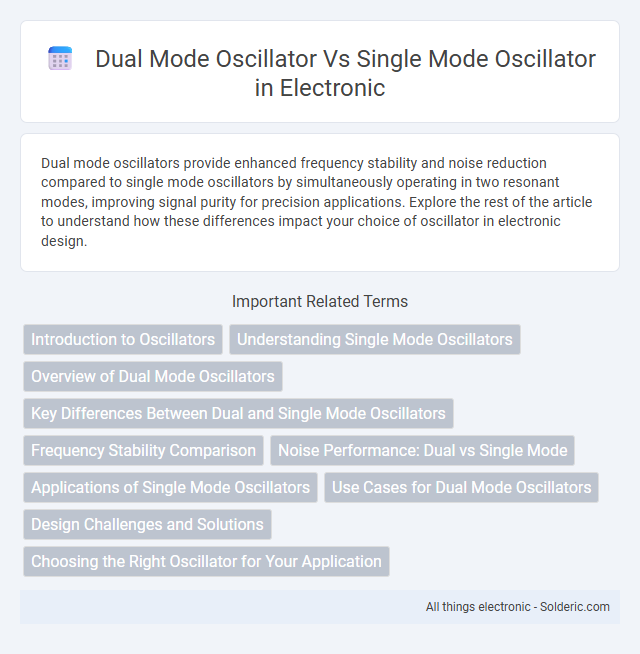Dual mode oscillators provide enhanced frequency stability and noise reduction compared to single mode oscillators by simultaneously operating in two resonant modes, improving signal purity for precision applications. Explore the rest of the article to understand how these differences impact your choice of oscillator in electronic design.
Comparison Table
| Feature | Dual Mode Oscillator | Single Mode Oscillator |
|---|---|---|
| Operating Modes | Supports two distinct oscillation modes | Supports one oscillation mode |
| Frequency Stability | Higher stability via mode coupling | Moderate stability, depends on single mode |
| Complexity | More complex design and tuning | Simpler design and easier tuning |
| Application | Used where selectable frequencies or enhanced stability are required | Used for standard frequency generation |
| Size and Cost | Typically larger and costlier due to dual components | Smaller and more cost-effective |
| Mode Switching | Capable of switching between modes | Fixed single operating mode |
Introduction to Oscillators
Oscillators are electronic circuits that generate periodic waveforms, essential for timing and signal generation in various applications. Single mode oscillators produce a stable, single frequency output, ideal for precise clock signals and communication systems. Dual mode oscillators, incorporating two resonance modes within one device, offer enhanced functionality such as frequency tuning and mode switching, making them suitable for complex signal processing tasks.
Understanding Single Mode Oscillators
Single mode oscillators operate by generating a stable and narrow frequency output through the resonance of a single mode within the oscillator's cavity or circuit, ensuring minimal phase noise and high spectral purity. This makes single mode oscillators ideal for applications requiring precise frequency control, such as in communication systems, radar, and signal processing. Understanding single mode oscillators helps you optimize your system's performance by choosing devices that deliver consistent and reliable frequency signals.
Overview of Dual Mode Oscillators
Dual mode oscillators generate two distinct resonant frequencies within a single device by utilizing orthogonal modes, enabling multifunctional signal processing and frequency synthesis in compact form factors. They improve system integration by providing enhanced frequency stability and reduced phase noise compared to single mode oscillators, which operate at a single resonant frequency. Commonly found in advanced communication systems and sensor applications, dual mode oscillators offer greater design flexibility and performance optimization.
Key Differences Between Dual and Single Mode Oscillators
Dual mode oscillators generate two distinct frequencies simultaneously from a single device, offering enhanced flexibility in frequency selection and application compared to single mode oscillators, which produce only one frequency. The key differences lie in their operational complexity, with dual mode oscillators requiring more intricate circuit design to maintain frequency stability across both modes, whereas single mode oscillators benefit from simpler architectures and typically achieve higher stability at a single frequency. Dual mode oscillators are favored in advanced communication systems and multi-band applications, while single mode oscillators remain prevalent in standard frequency generation tasks due to their ease of implementation and cost-effectiveness.
Frequency Stability Comparison
Dual mode oscillators offer enhanced frequency stability compared to single mode oscillators by utilizing two resonant modes to compensate for environmental variations such as temperature and pressure changes. Single mode oscillators rely on a single resonance path, making their frequency more susceptible to drift and noise interference. Your application benefits from dual mode oscillators when precise and consistent frequency output is critical over varying operational conditions.
Noise Performance: Dual vs Single Mode
Dual mode oscillators typically exhibit lower phase noise compared to single mode oscillators due to their ability to suppress unwanted modes and reduce spurious signals. The enhanced noise performance in dual mode oscillators results from improved mode discrimination and stable frequency output, which is critical for high-precision applications in communication and sensing systems. Your choice of oscillator will significantly impact the overall signal integrity and system reliability, especially in noise-sensitive environments.
Applications of Single Mode Oscillators
Single mode oscillators are widely used in high-precision applications such as communication systems, signal processing, and frequency synthesis where stability and narrow spectral linewidth are crucial. They provide a stable output frequency with minimal phase noise, making them ideal for use in atomic clocks, radar systems, and laser-based measurement devices. Your projects requiring consistent frequency performance benefit significantly from the reliable operation of single mode oscillators.
Use Cases for Dual Mode Oscillators
Dual mode oscillators are ideal for precision timekeeping and frequency synthesis in telecommunications, where simultaneous generation of two frequency signals improves phase noise performance and system stability. Their ability to support frequency hopping and modulation schemes makes them crucial in advanced wireless communication systems and radar applications. Compared to single mode oscillators, dual mode variants enhance signal reliability in multiplexed and multi-band environments, enabling versatile use in modern electronics.
Design Challenges and Solutions
Dual mode oscillators face design challenges such as mode coupling interference and frequency stability issues that are less prevalent in single mode oscillators. Solutions involve precise resonator design, temperature compensation techniques, and advanced signal isolation to maintain clean dual-frequency outputs. Your system benefits from these innovations by achieving enhanced performance without sacrificing reliability.
Choosing the Right Oscillator for Your Application
Dual mode oscillators provide enhanced frequency stability and noise performance by utilizing two resonant modes simultaneously, making them ideal for applications requiring precise signal integrity. Single mode oscillators offer simplicity and lower cost, suitable for less demanding environments where ultra-high accuracy is not critical. Your choice depends on the required frequency stability, phase noise tolerance, and budget constraints of your specific application.
Dual mode oscillator vs Single mode oscillator Infographic

 solderic.com
solderic.com